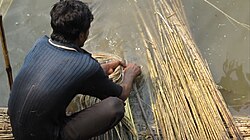Baishya Kapali (Bengali: বৈশ্য কাপালি) is a Bengali Hindu agricultural caste found in the Indian state of West Bengal and in Bangladesh. From the 1960s, a section of the Kapali caste embraced 'Baishya Kapali' as their caste name, which remains a matter of dispute to date. The Kapalis have excelled in cultivating jute and the manufacture of gunny bags. Baishya Kapalis or Kapalis are listed as Other Backward Classes in West Bengal.
Mythology
The ninth of the eleven Rudras of the thirty-three crore gods of Hindu pantheon is known as Kapali. According to Vamana Purana the Rudras were the sons of Kashyap and Aditi, while Matsya Purana mentions them as the offspring of the union between Brahma and Surabhi. The Harivamsa, an appendix to the Mahabharata mentions the Rudras as the children of Kashyap and Surabhi. The Adiparva of Mahabharata states that Kapali married the daughter of a sage and begot a son. According to Shourindra Kumar Ghosh, the progeny of their offspring came to be known as the Kapalis.
History

The Dom, Chandal, Savar, and Kapali were the cluster conferred as tribes during the Pala regime. According to Sarma, this caste was higher in status than the Dom and the so-called Chandal.
The caste claims to be of higher rank than the Bhūinmāli, Chandāl, or Sáha, and being descended from clean Südras the pure Dhobi and Nápit work for them. They adopted "Vaishya Kapali" caste name, to put forward the vaishya varna affiliation. The Purohit, who is distinct from that of the Kawāli, is a Patit Brähman. Their only gotra is Kasyapa; and the caste Panchäft is presided overby a headman, called Mu'tabar. The titles (surnames) found among the Kapális are Manjhi, Mandal, Shikdar, Mala, and Haldar; the families with the first three patronymics being regarded as higher than the others, while a larger sum is paid for their daughters. According to Sarkar, the Kapalis were arranged horizontally into elucidated and organised classes; the custom of kulinism was also exercised by them.
After the demotion in the social strata, the Kapalis took to agriculture, dairy farming and business. The Kapalis excelled in the cultivation of jute and the preparation of gunny bags from jute. Gradually they became prosperous and some of them even became wealthy landowners. During the reign of Maharaja Pratapaditya, many Kapalis were employed in the government as well as in the army. The Kapalis do not work as labourers, servants or domestic helps.
Ethnology

The Kapalis usually have two gotras - Kashyap and Shiva. However Santosh Kumar Kundu mentions three gotras namely, Kashyap, Alambayana and Moudgalya. Some Kapalis still use Kapali as their surname.
Religion
The Kapalis were originally Shaivites belonging to the school of Kashmir Shaivism, but later they embraced Buddhism. After the Bhakti movement, the Kapalis became Vaishnavas. In the present day, the majority of the Kapalis are Vaishnavas with a minority being Shaktas. The Kapalis follow the religious rituals with great devotion and piety. The Kapalis have separate Brahmins known as Goswamis. Satish Chandra Mitra too mentions that the Kapalis have separate Brahmins to serve them.
References
- "List of Other Backward Classes (O.B.C.) Recognized by Govt. of West Bengal" (PDF). Archived from the original (PDF) on 13 November 2014.
- Sarkar, Prasenjit (2017). "Multiple Identities of the Kapalis of Bengal: An Ethnohistorical Perspective". Anthropos. 112 (1): 282–289. doi:10.5771/0257-9774-2017-1-282. ISSN 0257-9774. JSTOR 44789610.
- Ghosh, Shourindra Kumar. Bangali Jati Parichay [An Introduction of Bengali Castes] (in Bengali). Kolkata. p. 27.
- Sarma, Jyotirmoyee (1980). Caste Dynamics Among the Bengali Hindus. Firma KLM. p. 19. ISBN 978-0-8364-0633-7.
- Sarkar, Prasenjit (1 January 2013). "Social Structure of the Kapalis of Bengal An Oral Historical Approach". Anthropos: International Review of Anthropology and Linguistics. 108: 137–147. doi:10.5771/0257-9774-2013-1-137.
- Saha, Sanghamitra (1998). A Handbook of West Bengal. International School of Dravidian Linguistics. pp. 72–74. ISBN 978-81-85692-24-1.
- Sarkar, Prasenjit; Mukherjee, D. P. (2010). "Patterns of Marriage among a Hindu Caste Population of the Southern Part of West Bengal, Bordering Bangladesh". Anthropos. 105 (2): 583–587. ISSN 0257-9774. JSTOR 25734824.
- ^ Kundu, Santosh Kumar (2008). বাঙালী হিন্দু জাতি পরিচয় [An Introduction of Bengali Hindu Castes] (in Bengali). Kolkata: Presidency Library. p. 80. ISBN 978-81-89466-13-8.
- Mitra, Satish Chandra. Jashor Khulnar Itihas [The History of Jessore and Khulna] (in Bengali). Kolkata: Deys Publishing. p. 345.
- ^ Mitra, Satish Chandra. যশোর খুলনার ইতিহাস [The History of Jessore and Khulna] (in Bengali). Kolkata: Deys Publishing. p. 1035.
